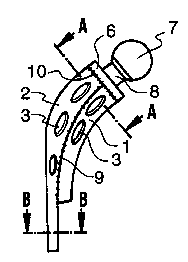Some of the information on this Web page has been provided by external sources. The Government of Canada is not responsible for the accuracy, reliability or currency of the information supplied by external sources. Users wishing to rely upon this information should consult directly with the source of the information. Content provided by external sources is not subject to official languages, privacy and accessibility requirements.
Any discrepancies in the text and image of the Claims and Abstract are due to differing posting times. Text of the Claims and Abstract are posted:
| (12) Patent: | (11) CA 2006595 |
|---|---|
| (54) English Title: | METHOD FOR PRODUCING A HOLLOW SHAFT ENDOPROSTHESIS |
| (54) French Title: | METHODE DE PRODUCTION D'ENDOPROTHESE A AXE CREUX |
| Status: | Term Expired - Post Grant Beyond Limit |
| (51) International Patent Classification (IPC): |
|
|---|---|
| (72) Inventors : |
|
| (73) Owners : |
|
| (71) Applicants : |
|
| (74) Agent: | MOFFAT & CO. |
| (74) Associate agent: | |
| (45) Issued: | 2001-05-08 |
| (22) Filed Date: | 1989-12-22 |
| (41) Open to Public Inspection: | 1990-06-23 |
| Examination requested: | 1996-09-17 |
| Availability of licence: | N/A |
| Dedicated to the Public: | N/A |
| (25) Language of filing: | English |
| Patent Cooperation Treaty (PCT): | No |
|---|
| (30) Application Priority Data: | ||||||
|---|---|---|---|---|---|---|
|
Method for producing a hollow shaft
endoprosthesis, in particular a hip joint prosthesis,
comprises the stages of producing two half-tubings,
which may be connected together to form the shape of
the shaft of the prosthesis, whereby they touch in
the region of two welding seams substantially running
in a longitudinal direction, by moulding or forging,
and welding together both moulded or forged
half-tubing in the region of the welding seams.
Note: Claims are shown in the official language in which they were submitted.
Note: Descriptions are shown in the official language in which they were submitted.

2024-08-01:As part of the Next Generation Patents (NGP) transition, the Canadian Patents Database (CPD) now contains a more detailed Event History, which replicates the Event Log of our new back-office solution.
Please note that "Inactive:" events refers to events no longer in use in our new back-office solution.
For a clearer understanding of the status of the application/patent presented on this page, the site Disclaimer , as well as the definitions for Patent , Event History , Maintenance Fee and Payment History should be consulted.
| Description | Date |
|---|---|
| Inactive: Expired (new Act pat) | 2009-12-22 |
| Inactive: IPC from MCD | 2006-03-11 |
| Inactive: IPC from MCD | 2006-03-11 |
| Inactive: IPC from MCD | 2006-03-11 |
| Inactive: Cover page published | 2001-06-11 |
| Inactive: Acknowledgment of s.8 Act correction | 2001-06-11 |
| Inactive: Prior art correction | 2001-06-11 |
| Grant by Issuance | 2001-05-08 |
| Inactive: Cover page published | 2001-05-07 |
| Pre-grant | 2001-02-14 |
| Inactive: Final fee received | 2001-02-14 |
| Notice of Allowance is Issued | 2000-08-30 |
| Notice of Allowance is Issued | 2000-08-30 |
| Letter Sent | 2000-08-30 |
| Inactive: Delete abandonment | 2000-08-25 |
| Inactive: Office letter | 2000-08-25 |
| Inactive: Adhoc Request Documented | 2000-08-25 |
| Inactive: Status info is complete as of Log entry date | 2000-07-18 |
| Inactive: Application prosecuted on TS as of Log entry date | 2000-07-18 |
| Inactive: Abandoned - No reply to Office letter | 2000-07-11 |
| Inactive: Received pages at allowance | 2000-07-10 |
| Inactive: Office letter | 2000-04-11 |
| Inactive: Approved for allowance (AFA) | 2000-04-06 |
| All Requirements for Examination Determined Compliant | 1996-09-17 |
| Request for Examination Requirements Determined Compliant | 1996-09-17 |
| Application Published (Open to Public Inspection) | 1990-06-23 |
There is no abandonment history.
The last payment was received on 2001-04-09
Note : If the full payment has not been received on or before the date indicated, a further fee may be required which may be one of the following
Patent fees are adjusted on the 1st of January every year. The amounts above are the current amounts if received by December 31 of the current year.
Please refer to the CIPO
Patent Fees
web page to see all current fee amounts.
| Fee Type | Anniversary Year | Due Date | Paid Date |
|---|---|---|---|
| MF (application, 9th anniv.) - standard | 09 | 1998-12-22 | 1998-04-20 |
| MF (application, 10th anniv.) - standard | 10 | 1999-12-22 | 1999-04-16 |
| MF (application, 11th anniv.) - standard | 11 | 2000-12-22 | 2000-04-14 |
| Final fee - standard | 2001-02-14 | ||
| MF (application, 12th anniv.) - standard | 12 | 2001-12-24 | 2001-04-09 |
| MF (patent, 13th anniv.) - standard | 2002-12-23 | 2002-11-19 | |
| MF (patent, 14th anniv.) - standard | 2003-12-22 | 2003-11-17 | |
| MF (patent, 15th anniv.) - standard | 2004-12-22 | 2004-11-08 | |
| MF (patent, 16th anniv.) - standard | 2005-12-22 | 2005-11-08 | |
| MF (patent, 17th anniv.) - standard | 2006-12-22 | 2006-11-08 | |
| MF (patent, 18th anniv.) - standard | 2007-12-24 | 2007-11-09 | |
| MF (patent, 19th anniv.) - standard | 2008-12-22 | 2008-11-10 |
Note: Records showing the ownership history in alphabetical order.
| Current Owners on Record |
|---|
| JOHNSON & JOHNSON |
| Past Owners on Record |
|---|
| CURT KRANZ |